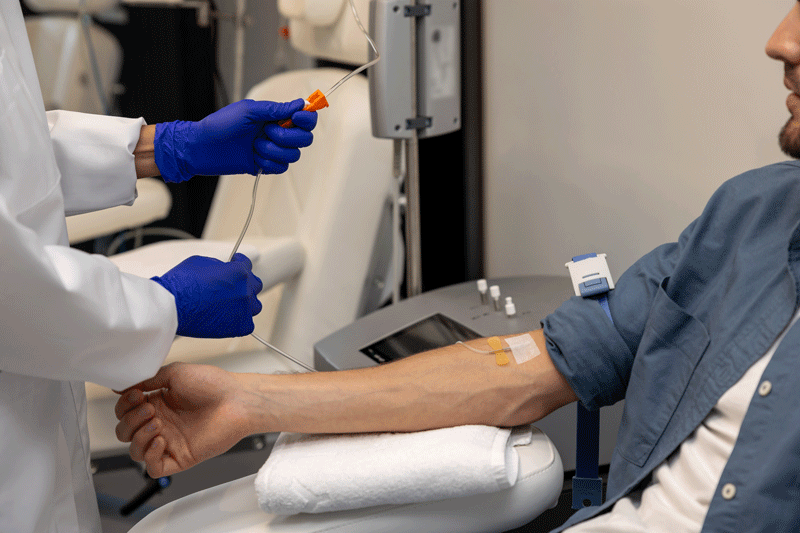Potentially Lifesaving Cancer Treatment
CAR T-Cell Therapy
Revolutionary immunotherapy for blood cancers
Car-T Cell Therapy is precisely designed to treat B-cell acute lymphoblastic leukemia, diffuse large B-cell lymphoma, chronic lymphocytic leukemia, small lymphocytic lymphoma, mantle cell lymphoma, primary mediastinal lymphoma, follicular lymphoma and multiple myeloma.
Henry Ford Health is one of the few medical centers in Michigan that is certified to administer a personalized immunotherapy treatment called chimeric antigen receptor (CAR) T-cell therapy that’s been shown to increase survival. Thanks to our ongoing participation in clinical trials and our work with advanced stages of cancer, we have the expertise, technology and resources that allow us to offer this cancer treatment to select patients. We continue to increase the amount of CAR T-cell infusions we perform each year.
Our cancer team is specially trained to administer and conduct CAR T-cell therapy to patients with blood cancers like B-cell acute lymphoblastic leukemia (ALL), diffuse large B-cell lymphoma, chronic lymphocytic leukemia, small lymphocytic lymphoma, mantle cell lymphoma, primary mediastinal lymphoma, follicular lymphoma and multiple myeloma.
In addition to killing cancer cells, CAR T-cell therapy may help protect patients against cancer recurrence and may result in long-term remission.
Connect with our Cancer Team 24/7. Call us at (888) 777-4167
What is CAR-T cell therapy?
CAR T-cell therapy is a one-time treatment at the forefront of personalized medicine that uses engineered cells from a patient’s immune system to destroy cancer.
This therapy “supercharges” a type of immune cell in the body called T-cells to target and destroy cancer cells – much like the immune system would work to fight the common cold. Unlike chemotherapy that treats the whole body to kill cancer cells, CAR T-cell therapy targets just the cancer cells.
CAR T-cell therapy is sometimes called a “living drug” because the fighting T-cells remain active in the body for many years after the treatment. If cancer cells try to relapse, the CAR T-cells have a greater chance of recognizing and destroying the cancerous cells.
How CAR T-cell therapy works:
- T-cells are removed from the patient in a process similar to donating blood. After the cells have been separated from the blood, the blood is immediately infused back into the patient.
- In the manufacturing laboratory, scientists insert a new gene into the T-cells. The gene contains instructions for the T-cell to make and add a new protein to the surface of the T-cells. That protein is called a chimeric antigen receptor (CAR). It is designed to find the cancer cells.
- While the CAR T-cells are multiplying in the manufacturing center, the patient remains out of the hospital and may receive a brief course of chemotherapy.
- When millions of CAR T-cells have been grown – this may take a few weeks – the cells are frozen and delivered to the hospital where they are infused back into the patient. The CAR T-cells will continue to multiply in the patient and attack the cancer cells, working as a “living drug.”
Like many other cancer-fighting drugs, CAR T-cell therapy can produce side effects. Our experts will discuss possible side effects with you before treatment. In certain cases, patients have severe flu-like symptoms caused by the strong action of the T-cells as they fight cancer. Others may experience confusion or additional neurological symptoms that can be reversible.
To monitor patients closely after therapy is administered, we require that they return to Henry Ford Cancer. They may be admitted to the hospital for two or more weeks. Patients are cared for in the transplant unit - and if needed intensive care unit - and they are given medication to treat side effects. This helps patients ensure that everything possible is being done to manage their care.

Henry Ford’s team approach to CAR T-cell therapy and care
To manage your CAR T-cell therapy and address all of your needs, we have a team that includes:
- CAR T-cell physicians
- Cancer surgeons
- Transplant coordinators
- Pathologists
- Social workers
- Psychiatrists
- Nurse navigators and nurse coordinators
- Financial coordinators to navigate insurance coverage
What to expect at your first CAR T-cell therapy appointment:
- You will first meet with a medical oncologist (cancer doctor) who specializes in your type of cancer.
- Our CAR T-cell team, which includes experts from several cancer specialties, will work together to review your bloodwork and imaging to begin treatment planning.
- Our CAR T-cell team’s social workers, psychiatric experts and financial coordinators will meet with you to evaluates any needs you may have -- from transportation to insurance coverage.
- You will be assigned a nurse navigator who will schedule your appointments.
- You will meet with our transplant coordinators.
Our goal is to make the process very easy for you, so you can learn more and move forward with CAR T-cell therapy.
.svg?iar=0&hash=F6049510E33E4E6D8196C26CCC0A64A4)

/hfh-logo-main--white.svg?iar=0&hash=ED491CBFADFB7670FAE94559C98D7798)